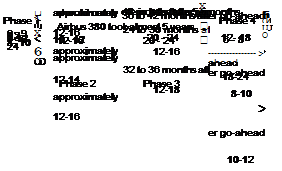Phase 1: Conceptual Study Phase (Feasibility Study)
Much of the work in the conceptual study phase can be streamlined through a good market study to identify a product line within a company’s capabilities. In this phase, findings of the market study are developed with candidate configurations; the technology to be adopted is firmed up and the economic viability is finalized. This is accomplished through aircraft sizing, engine matching, preliminary weight estimation, and evolution of a family of aircraft with payload and range combinations (i. e., aircraft performance) for all configurations. Planning portfolios with budgetary provisions, manpower requirements, progress milestones, potential subcontract/risk-sharing partners’ inputs, and so forth are included as the starting point of the design process. In general, at the end of this phase, management decision for a go-ahead is expected with a final configuration selected from the candidate configurations offered. Continuous interaction with potential customers (i. e., operators and subcontractors) occurs during this phase, with the objective of arriving at a family of aircraft as the most “satisfying” design with compromises rather than an
 |
 |
Combat If technology demonstrator time is included, then it could take a decade.
Aircraft Flight-testing time would be about twice that of large civil aircraft because
of weapons and systems integration of many new technologies.
Military aircraft projects have large variations.
Chart 2.4. Typical project time frame “optimum” solution. Management may request a level of detail (e. g., risk analysis) that could extend the study phase or flow into the next phase, thereby delaying the go-ahead decision to the early part of Phase 2. This is likely if the candidate aircraft configurations are short-listed instead of finalized. For those designers who have planned ahead, Phase 1 should finish early – especially if they are well versed in the product type and have other successful designs in their experience.
Phase 2: Project Definition Phase (Preliminary Design)
This phase begins after the go-ahead has been given to a project, and a “point of no-return” is reached during this phase. Project definition sometimes may overlap with the detailed design phase (i. e., Phase 3). During the advanced design phase, the project moves toward a finer definition, with a guarantee that the aircraft capabilities will meet if not exceed the specifications. Some iteration invariably takes place to fine-tune the product. Details of the technology level to be used and manufacturing planning are essential, and partnership outsourcing is initiated in this phase. Procurement cost reviews and updates also are ongoing to ensure that project viability is maintained. Many fine aircraft projects have been stalled for lack of proper
planning and financial risk management. (Readers may study recent case histories of products such as the Swearingen SJ30 [now certified and under production] and the Fairchild-Dornier 928.) The beginning of metal cutting and parts fabrication as well as deliveries of bought-out items (e. g., engine and avionics) must be completed in Phase 2. In this phase, extensive wind-tunnel testing, CFD analysis, detailed weights estimation, detailed structural layout and FEM analysis, system definitions, production planning, and so forth are carried out.
Phase 3: Detailed Design Phase (Full-Scale Product Development)
In this phase, manufacturers push toward completion – when peak manpower is deployed for the project. Normally, projects cannot sustain delay – time is money. All aspects of detailed design and systems architecture testing are completed in this phase. (The test rig is called an “iron bird” – it simulates full-scale control and system performance.) At the end of Phase 3, the aircraft assembly should near, if not achieve, completion.
Phase 4: Final Phase (Certification)
Phase 4 must start with the rapid completion of the aircraft assembly for groundtesting of installed systems and other mandatory structural strength-testing to prepare for flight-testing. In general, two to four aircraft are needed to complete nearly 200 to 800 flight-testing sorties (depending on the type of aircraft) toward substantiation for certification of the airworthiness standard. At this stage, there should be no major setbacks because the engineers have learned and practiced aircraft design well with minimal errors.
Each project has a characteristic timeline; – this book uses a 4-year project time. Remember, however, that some projects have taken more or less time. Section 2.4.2 is a detailed breakdown of a small aircraft project for a small or medium company. The author recommends that similar detailed milestone charts be drawn for course – work projects to give an idea of the manpower requirements.











